The use of potato starch in folk medicine and in everyday life
In every housewife's house, somewhere on the far shelf, there is almost certainly starch. With its help, collars are shaped, bed linen is refreshed, delicious jelly is cooked and airy dough is prepared. The use of starch is extremely diverse - on its basis, "dry shampoos" for animals, natural antiperspirants and traditional medicine are prepared.
Let us consider this compound in detail, of which there are so many in potatoes and jelly, find out its benefits and harm to humans and the scope of application.
The content of the article
Potato starch, characteristics and description
Potato starch belongs to the group of polysaccharides - high molecular weight carbohydrates that perform structural and many other functions in living organisms. In particular, it is an energy accumulator from which the body takes the necessary sugars for functioning. Due to the properties of the polymer, sugar is converted from it gradually, as needed.
The starch is sold and stored as a free-flowing powder. It can be bright white, white-gray, sometimes yellowish - depending on the variety and the amount of impurities. It has no smell or taste.
On contact with hot water, the polymer forms a viscous bulk. When combined with cold water, the product becomes insoluble and forms a paste.
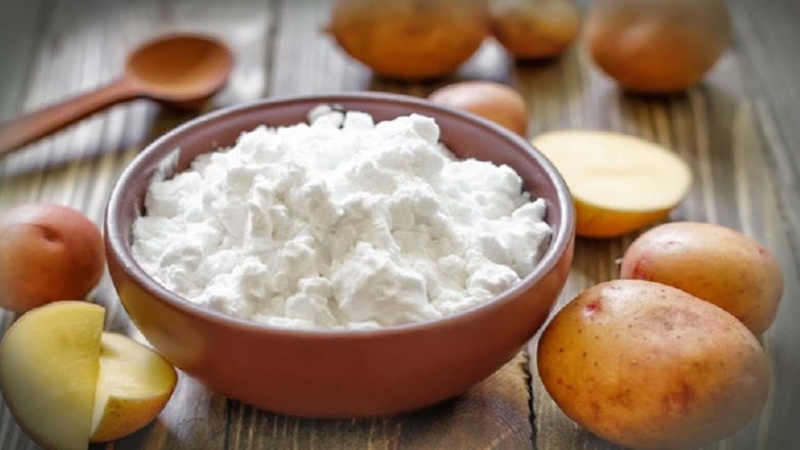 The shelf life of a food product is indicated on the packaging and on average ranges from 2 to 5 years from the date of production without loss of properties. The powder is stored in a dry, cool place protected from sunlight. Improper storage of starch will reduce the shelf life.
The shelf life of a food product is indicated on the packaging and on average ranges from 2 to 5 years from the date of production without loss of properties. The powder is stored in a dry, cool place protected from sunlight. Improper storage of starch will reduce the shelf life.
Starch is found naturally in many foods (eg potatoes and grains) and as a food additive (sauces, confectionery). The processes of splitting this compound begin in the human mouth, therefore starchy foods require careful chewing. In combination with other food products, except for vegetables and fruits, as well as with a deficiency of vitamin B, its absorption is difficult.
The food additive is masked with codes E1400 – E1405... If the digital value starts with 14, it means that you have a modified form. Such a product is less useful for humans, but also has nothing to do with genetic experiments and "chemistry". It is just that with the help of certain technologies, the starch was brought to the desired state (more crumbly, etc.).
The recommended daily allowance of the product is 50 g (1 tbsp. L. Or 2 tsp.).
Why is there a lot of starch in potatoes? This is the natural property of this vegetable. In different varieties, its content is increased or decreased. Basically, its concentration in tubers is about 70% of all dry matter.
For reference. In addition to potatoes, the main sources of starch are corn and rice.
Starch varieties

Regardless of the type and variety, starch should not contain foreign smells and tastes.The mechanical part of potato starch processing is regulated by the system of national state quality standards. The variety is determined by the degree of purification, granularity and acidity.
According to GOST, starch is divided into 4 grades:
- Extra. Crystalline luster is characteristic. The graininess of the product is visually visible. Allowable grain content - 60 pcs. by 1 dm².
- Higher. Has the same characteristics as the extra variety. Granularity - 280 pcs. by 1 dm².
- The first. A grayish tint prevails, sometimes a sour smell is felt. The content of grains reaches 700 pieces. 1 dm².
- Second. It is used for technical purposes, so the grain size of the product does not matter. It is in demand in the printing house and in the production of textile products.
For home use, it is better to choose extra and premium starch.
For reference. High-quality polymer is crumbly, does not have lumps. If you rub a pinch of the product between your fingers, you can hear a slight squeak.
Composition, energy value, trace elements and KBZhU
The energy value of the polymer is 313 kcal per 100 g of BJU:
- proteins - 0.1 g;
- fats - 0 g;
- carbohydrates - 78.2 g.
Composition - a mixture of amylopectin and amylose. Of the vitamins, starch contains only PP. Microelements are presented more diversely:
- calcium;
- potassium;
- phosphorus;
- sodium.
Also, 100 g of starch accounts for 1.4 g of dietary fiber.
Useful properties of potato starch for humans
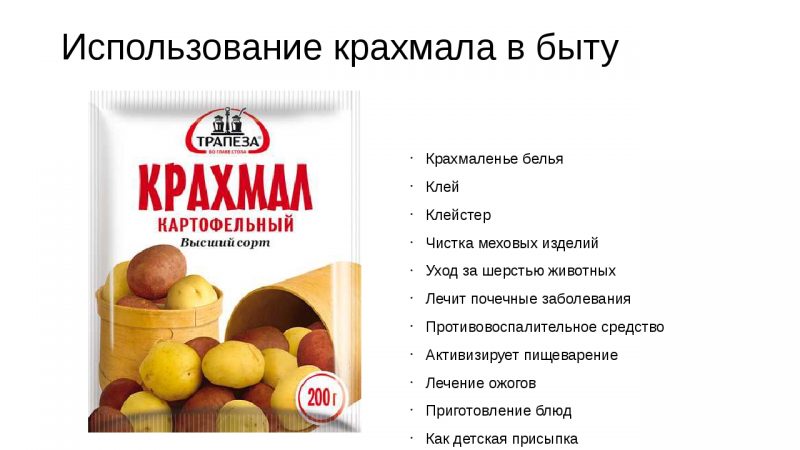
How is starch useful for humans? The most pronounced benefits of the product are noted for the gastrointestinal tract. The polymer normalizes the acidity of gastric juice. Prevents many serious problems with the intestines due to the regenerative, hemostatic, anti-inflammatory, enveloping action. It is these properties of the polymer that are beneficial for gastritis and ulcers.
Starch exists in a simple and resistant form. Each of them has certain benefits for the human body:
- Plain. Easily digestible species. Energizes the body by converting it to glucose.
- Resistant. Normalizes blood sugar levels, increases insulin sensitivity. Resistant to most enzymatic processes. Passes through the digestive tract practically unchanged. In the large intestine, it becomes a breeding ground for beneficial microflora, promotes the assimilation of micro- and macroelements from food, increases the body's ability to eliminate toxins.
Starch belonging to a particular type is unstable. For example, mashed potatoes contain a simple polymer, while chilled potatoes contain a resistant one.
With regular use of starch, the level of bad cholesterol decreases, which serves as an excellent prevention of atherosclerosis. Also, the product activates the synthesis of vitamin B2 in the body.
Other beneficial properties include:
- quenching thirst and dulling hunger;
- removal of excess fluid, elimination of puffiness;
- prevention of the formation of pathogenic cells.
The phosphorus and calcium content in starch has a beneficial effect on the condition of human hair, nails, bones and teeth.
The harm of starch to the human body
There are no contraindications to the use of starch, but its excess will cause discomfort in the gastrointestinal tract, increased gas formation, constipation, will cause extra pounds in people with a tendency to overweight.
The constant presence of refined starch in the diet threatens to increase blood sugar levels, hormonal disorders.
The modified polymer can do more harm. There is a theory that it slows down digestion, drains blood vessels.
Thermally processed polymer provokes premature aging of the body and increases the risk of developing cancer.
The use of starch in the treatment of diseases
Potato flour is found in many medicines. The range of application of starch in folk medicine is limitless. It is used for colds, diseases of the gastrointestinal tract, to normalize blood pressure and etc. diseases. It can help stop bleeding and get rid of diaper rash.
For the stomach and intestines
For diseases of the stomach and intestines, it is recommended to use 1 tsp. starch three times a day 15-20 minutes before meals. Drink with warm water.
For gastrointestinal disorders, prepare a medicinal solution:
- Pour 1 tbsp into 125 ml of warm water. l. starch.
- Add 5 drops of iodine, stirring constantly. The solution turns blue.
- Drink in one gulp, repeat if necessary.
During pregnancy
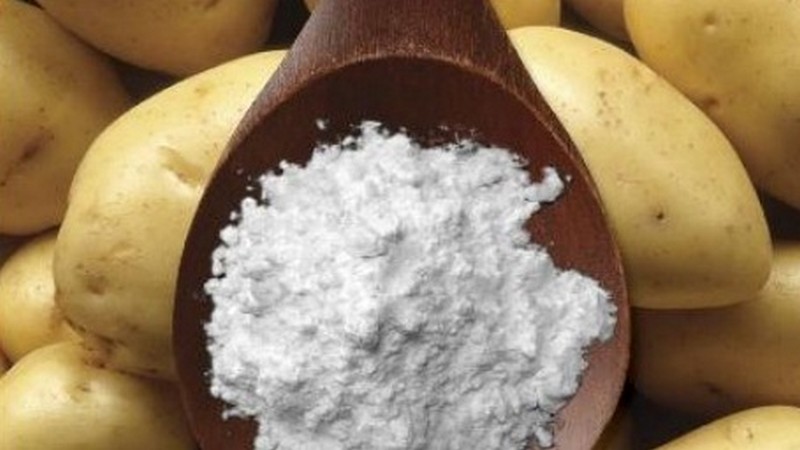
During pregnancy, you can reduce high blood pressure using a polymer. To do this, use a starch solution (15 g per 0.5 tbsp. Warm water) daily for 10-14 days. Monitoring of pressure indicators is required.
From diaper rash
An effective dusting powder made from starch, talc and zinc oxide. The components are mixed in equal proportions. It also helps with bedsores in bedridden patients.
For reference... Starch stops bleeding. To do this, sprinkle the wound with powder.
For dermatitis
For skin diseases (eczema, allergies), the polymer is used externally as a powder. Rubbing the product into the affected areas is allowed.
Baths with starch are effective: 4-5 tbsp. l. Pour boiling water over the product, stir. Add to bath. The optimum water temperature is no more than + 37 ° C. The duration of the procedure is 7-10 minutes. Frequency: the first 4 procedures with an interval of one day, the next 3 with an interval of 2 days, the last 2 procedures - 14 days in advance.
For diarrhea
Recipe for homemade analogue "Smekta": dilute 1 tbsp. l. starch in 125 ml of warm water, mix thoroughly and drink immediately. Repeat if necessary, but no more than 3 times a day.
From burns
Starch paste will help. To do this, mix the required amount of starch with water by eye. The product must have a pasty consistency. Apply to the burn site for 15-20 minutes, rinse.
With angina
To prepare a rinse solution for 0.5 tsp. starch is diluted in 1 tbsp. warm water. Add 5 drops of 5% iodine, mix thoroughly. Gargle 3-5 times a day. This recipe will relieve stomatitis.
With mastitis
A compress is prepared from ½ tbsp. vegetable oil and 3-4 tsp. starch. Place the mixture in a gauze bag and leave on the sore chest for 50-60 minutes.
Important. Traditional methods of treating mastitis, like other diseases, will not replace conservative therapy. To avoid complications, a doctor's consultation is necessary.
With ARVI
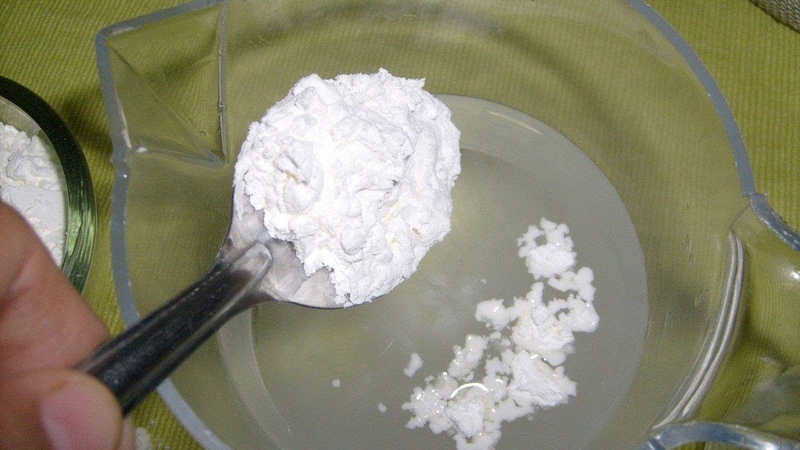
At the initial stage of the disease, a therapeutic mixture will help eliminate symptoms.... For this:
- Mix 0.5 tbsp. l. starch, 1 tbsp. l. honey, 2 tbsp. l. melted butter and 2 egg yolks.
- Mix thoroughly and take 1 tbsp one hour before meals. l. at least 3 times a day.
What else can be made from potato starch
In addition to treating various diseases, potato flour is successfully used in cosmetology. With its help at home, you can get rid of wrinkles, narrow pores, even out the tone of the face.
On the other hand, the unique properties of starch make it a versatile home remedy. The product will always help out if you don't have at hand, for example, the same wallpaper glue, insect bite repellent or detergent.
Paste
Paste recipe:
- Mix cold water and starch (1: 1) so that there are no lumps.
- Boil 800 ml of water in a separate container.
- Combine the liquids and bring to a boil, stirring thoroughly.
- When the consistency of the batter is reached, add a little PVA glue (for moisture resistance).
- Bring to a boil, cool and strain.
Starch glue is more suitable for light wallpaper. In other cases, it is better to use flour paste or industrial glue.
Detergent for windows
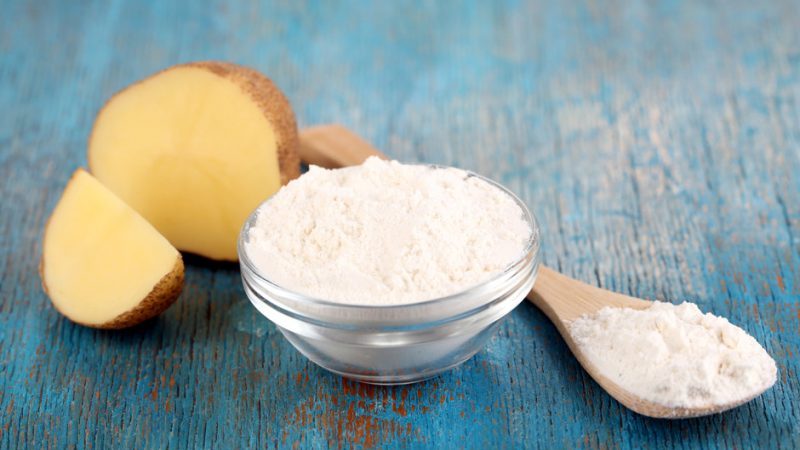
To prepare an environmentally friendly window cleaner, you must:
- Mix in 2 tbsp. water 1 tbsp. l. potato flour. To stir thoroughly.
- Add 50 g of vinegar and alcohol to the mixture. Shake vigorously.
- Pour into a spray bottle and start cleaning the windows.
- After drying, wipe them with a clean cloth. There will be no trace of dirt and streaks.
Soap substitute
Potato flour is great as a hygiene product. Add 1 tbsp for 1 liter of warm water. l. product. Wash your face and then rinse your face with plain water.
Insect Bite & Irritation Relief
You can quickly get rid of itchy skin with a starch solution. In 1 st. add 1 tsp of water. polymer. Treat irritated skin. The relief is felt immediately.
Mask for the face
The starch will keep the skin fresh and tone up. Mix kefir and polymer in equal proportions, apply on face for 30 minutes, rinse with warm water.
Deodorant
Potato flour is a wonderful base for natural deodorant. Mix starch and soda in equal proportions (¼ cup each), add 10 drops of tea tree oil and 2-3 tbsp. l. coconut oil. Stir until smooth. Add some vitamin E and any other essential oil if desired.
Silverware cleaner
You can also use a potato flour solution to shine table silver. Stir 2 tbsp. l. starch in 1 liter of water. Treat the devices with a solution, wipe dry.
Carpet stain remover
Sprinkle the stain with starch and leave overnight, and remove with a vacuum cleaner in the morning. If the stain doesn't come off the first time, prepare a starch gruel and add a few drops of pure gasoline to it. Then reapply to the greasy stain, followed by a standard carpet cleaning.
Council. You can noticeably refresh the carpet by sprinkling it with potato flour before harvesting. Leave for 30 minutes, vacuum.
Fat Solvent
Starch will remove grease from tiles, stoves or furniture. To do this, it is enough to clean with a small amount of potato flour applied to a dry rag.
Plasticine
Potato starch will add joy to your child. It makes an excellent soft plasticine. For this you will need:
- 1¼ st. cold water;
- 1 tbsp. starch;
- 2 tbsp. l. soda.
Mix the ingredients thoroughly. Add a few drops of gel dye if desired.
"Dry shampoo" for animals
You can clean your pet's fur without bathing. Rub the starch into it and comb out well with a brush.
For reference.An effective way to freshen up soft toys is to starch them, leave them for 30-40 minutes, and vacuum them.
Reviews
The successful use of starch in folk medicine and cosmetology is confirmed by numerous user reviews.
Veronica, 44 years old: “I came across an article and immediately remembered how my grandmother treated me with starch gruel on the wounds on my knees. The blood immediately stopped oozing. A good tool, you need to take note of yourself. "
Natalia, 52 years old: “It would seem that it is ordinary starch, but no ... For me, this is a super tool with a lifting effect. I heard that with this mask, Chinese women got a porcelain complexion. What I noted for myself: nourishes and tightens the skin, evens out the color. I share the recipe for the perfect mask: starch, salt, milk and honey. All in equal quantity. Use, do not thank. "
Irina, 30 years old: “For three years I have been suffering with a stomach ulcer. The doctor advised to take "blue iodine" periodically at home. I will warn you right away that this remedy is incompatible with medicines. I use it as a preventive measure, I'm happy with the effect. Usually exacerbation occurs in autumn and spring, but this spring has survived without relapse. "
Read also:
Is it possible to eat potatoes with high cholesterol.
Who grew the largest potato in the world and what does it look like.
Potato variety Galaktika with excellent taste and long shelf life.
Conclusion
Starch is used in everyday life as a cleaning agent, is a part of traditional medicine recipes, and is valued for its easy digestibility and high energy value.When using starch and potato flour to treat disease, remember that they are not a substitute for medication and can only be used as an adjunct to primary therapy.